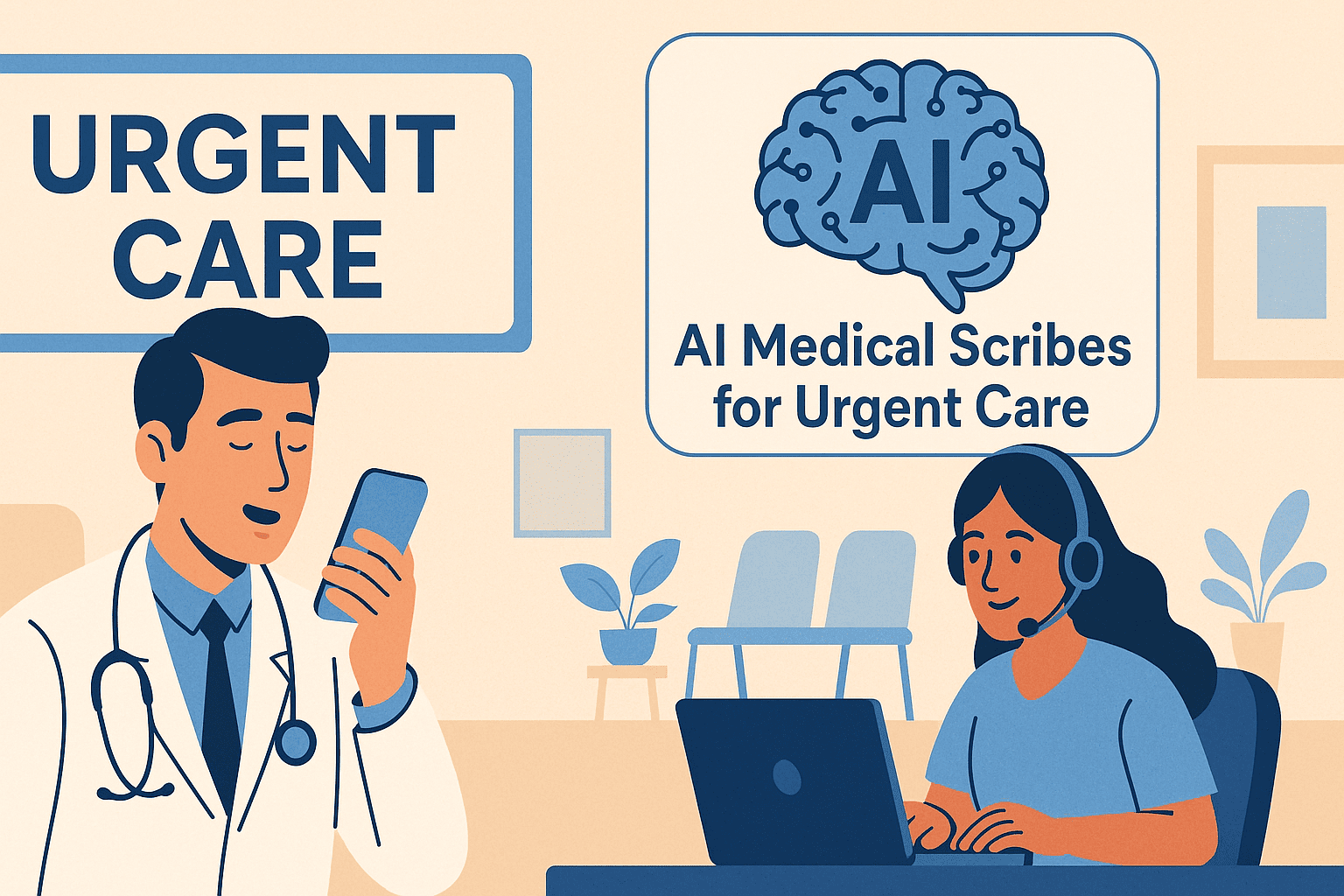Updated on: July 12, 2025
Urgent care centers thrive on speed. Whether treating a laceration, evaluating a sore throat, or managing a minor fracture, your goal is to diagnose, treat, and discharge—fast. But there’s a catch:
Every rapid encounter still needs complete, compliant documentation.
In a setting where providers see 30–50 patients a day, typing every SOAP note, discharge summary, and patient instruction can slow everything down. That’s why more clinics are adopting AI medical scribes for urgent care, like DocScrib, to handle documentation in real time—without missing a beat.
Why Documentation Slows Down Urgent Care Efficiency
Urgent care centers face unique documentation challenges:
-
Short, symptom-specific visits with high patient turnover
-
High risk of charting omissions under time pressure
-
Medication prescriptions, discharge instructions, and follow-up recommendations
-
Reimbursement tied to coding precision and clinical note quality
-
EMR fatigue during flu season, weekends, and peak surges
Without a streamlined solution, clinicians either sacrifice time or risk incomplete documentation.
What Is an AI Medical Scribe for Urgent Care?
An AI scribe listens in real time during the patient encounter and generates structured clinical documentation—live, as you work. Unlike standard transcription tools, AI scribes understand medical context and build out accurate SOAP notes, assessments, and plans with clarity.
Platforms like DocScrib are built for high-speed, episodic care settings like urgent care—where time is tight, but charting standards are still high.
How DocScrib Works in Urgent Care
-
Start the visit
DocScrib listens passively while you evaluate the patient—no clicking, typing, or voice commands needed. -
AI processes the encounter
It identifies complaints (e.g., “fever for 3 days”), physical findings (“pharyngeal erythema”), and plan (“prescribe amoxicillin”). -
Note generation
A structured note is ready in real time—with vitals, exam, assessment, and treatment all prefilled. -
Clinician review & EMR sync
You make final edits (if needed) and submit directly to the EMR in seconds.
Key Benefits for Urgent Care Providers
🕒 Save Up to 2+ Hours Daily
No more charting between patients or after your shift—DocScrib completes notes in real time.
📋 Rapid, Accurate SOAP Notes
Auto-generate complete, episodic visit documentation for common complaints like UTI, flu, rash, or laceration.
📄 Smart Discharge Summaries
Prescriptions, aftercare, and red flags are automatically included in the note.
📈 Boost Throughput Without Burnout
Clinicians can increase daily visits without sacrificing care or accuracy.
🔐 HIPAA-Compliant
DocScrib keeps data encrypted and compliant with end-to-end security and audit logging.
DocScrib for Urgent Care: Built for Fast Workflows
-
Urgent Care-Specific Templates
For fever, sore throat, injury, allergic reaction, GI upset, and more. -
Medications & Procedures Auto-Logged
From Zofran prescriptions to wound irrigation and splint applications. -
Customizable Discharge Instructions
Auto-filled with plan, red flags, and return-to-clinic guidance. -
Real-Time EMR Sync
Push notes to your EMR with a single click—fully mapped by section. -
CPT Code Support
Properly document complexity to support 99213, 99214, and urgent care coding tiers.
Top Use Cases for DocScrib in Urgent Care
-
Acute Visits: Cough, fever, sore throat, ear infections, nausea
-
Minor Injuries: Sprains, lacerations, minor fractures, burns
-
Procedures: Abscess drainage, wound repair, splinting
-
Medication Management: Antibiotic starts, antihistamines, pain relief
-
COVID & Flu: Symptom tracking, test result follow-up, isolation counseling
Real-World Case Study: Walk-In Clinic in Florida
📍 4 providers implemented DocScrib during winter flu surge
Results after 1 month:
-
85% reduction in documentation time
-
25% increase in patients seen per shift
-
Near-instant discharge note completion
-
Higher patient satisfaction due to faster check-in-to-check-out time
💬 “DocScrib captures everything, even while I’m giving instructions to the patient. By the time they leave, the note’s already done.”
DocScrib vs Traditional Charting in Urgent Care
| Feature | Manual Documentation | DocScrib AI Scribe |
|---|---|---|
| Real-Time SOAP Note | ❌ Typing required | ✅ Auto-generated instantly |
| Discharge Instructions | ❌ Manually copied | ✅ Auto-filled with plan |
| EMR Sync | ❌ Manual entry | ✅ 1-click push |
| Chart Completion After Shift | ✅ Often required | ✅ Zero backlog |
| Coding Support | ❌ Limited | ✅ AI-assisted |
FAQs: AI Scribes in Urgent Care
Q1. Can DocScrib handle fast-paced walk-in traffic?
Yes—it’s built for real-time, high-volume clinics and performs even during back-to-back visits.
Q2. Does it document procedures like I&D or splint application?
Yes—DocScrib captures procedures when you speak them aloud and maps them to CPT codes when applicable.
Q3. Is it accurate enough for pediatric urgent care?
Absolutely—DocScrib recognizes age-specific details and adjusts the note accordingly.
Q4. What if patients speak quickly or interrupt?
The AI is trained to handle rapid dialogue and recover context accurately.
Getting Started with DocScrib for Urgent Care
-
Book your demo
-
Select “Urgent Care” as your specialty
-
Set up your preferred templates
-
Start documenting while you treat patients—DocScrib handles the rest
Conclusion: Speed Without Compromise
Urgent care moves fast. So should your documentation.
AI medical scribes like DocScrib free up your time, reduce charting fatigue, and ensure every note is accurate, complete, and compliant—even on your busiest days.
Whether you run a single walk-in clinic or a multi-location urgent care chain, DocScrib helps you treat more, type less, and thrive in high-volume care.
⚡ Try DocScrib Today → Book a Demo
